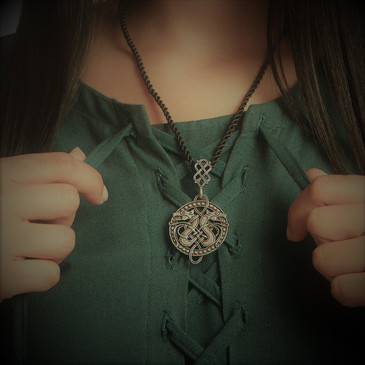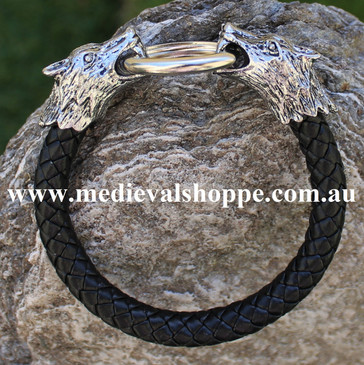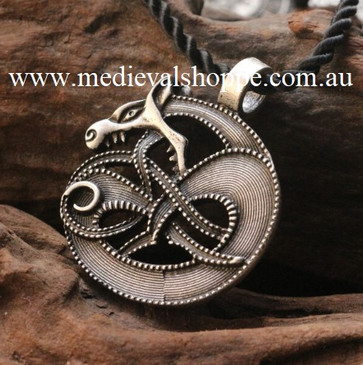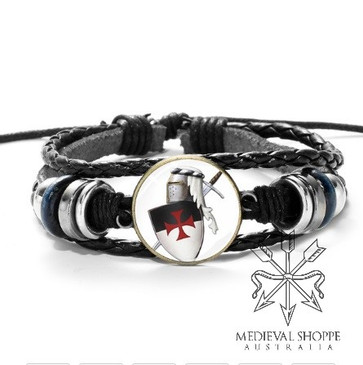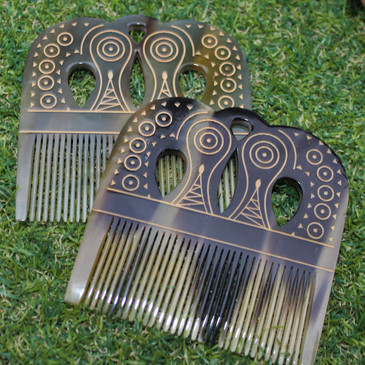-
Product Description

DRAGON BRACELET
23cm long (adjustable)
-0-
The Dragon is prominent not only in fairy lore and mediæval romances, but in ancient religious systems. In the mythical history of the East the dragon is the symbol of anarchy and destruction, and the idea was taken over by Christianity, which looked upon the dragon as an emblem of the devil. "The great dragon was cast out, that old serpent, he that is called the Devil and Satan" (Rev. xii, 9). In Ancient Egypt certain of the deities had serpentine forms, as have still some of the dragons of India, China, and Japan. The Egyptian 'fiery flying serpent' is a dragon, as is also the Apep serpent of night and death, through which the sun-barque of Ra was supposed to pass each night. Osiris, as the Nile, was a dragon on which were human heads. In the Pyramid Texts he is addressed as "the Great Green" (the Mediterranean Sea), and the one who is "round as the Great Circle (Okeanos)." On the sarcophagus of Seti I he is "Osiris encircling the Nether World." Set, who slew him, had a 'roaring serpent' form and hid in a hole; he resembled Typhon. The Babylonian dragon Tiamat was the Great Mother of all the deities, and was slain by her descendant Marduk (Merodach), who formed the earth and sky from her body; her blood ran as the flooded rivers to the sea. In India the drought-demon is a water confiner. When slain by Indra with the thunderbolt, the rainy season ensues. The Naga serpent-gods are dragons who may assume human or half-human, half-reptile forms. All the Chinese dragons have pearls in their mouths, and are supposed to spit out pearls. Dragon deities are connected with the moon, which is 'the night-shining pearl,' and in Mexico 'the pearl of heaven'. The Mexican dragon resembles the Chinese, Indian, and Babylonian dragons. The Indian wonder-beast, the Makara, the vehicle of the sea-god Varuna, is similar to the dragon of the Babylonian mother-goddess Ishtar seen on the famous Ishtar gate of Babylon. Makara forms include the lion-headed dolphin, the crocodile-headed fish, and the ram-headed fish so like the 'goat fish' or 'antelope fish' of the Babylonian sea-god Ea, and resembling the Greek horse-headed, dog-headed, and man-headed fish (Tritons). Japanese dragons are serpentine 'water fathers', which are prayed to in time of drought. The Chinese dragons are rain-bringers which sleep during the winter (the season of drought) in pools and rise to fight and thunder in spring. They are hatched from stones as snakes, or from sea-plants, or are transformed fish, or are born from aged pine trees. They are coloured according to their attributes, and may assume human forms or be horse-headed with a snake's tail. That the composite dragon-god is a mixture of several ancient animal-gods is evident by the following description of one class of dragon by a Chinese writer: "His horns resemble those of a stag, his head that of a camel, his eyes those of a demon, his neck that of a snake, his belly that of a clam, his scales those of a carp, his claws those of an eagle, his soles those of a tiger, his ears those of a cow." Dragons may transform themselves into fishes, snakes, crows, dogs, rats, cows, sharks, whales, crocodiles, &c., as well as human beings. The 'will o' wisp' is the 'dragon lantern', and the dragon pearl is the 'jewel that grants all desires' in India, China, and Japan. Shakespeare has interesting dragon references, including:
The dragon wing of night o'erspreads the earth,...
(Troilus and Cressida, V, 8, 17.)
Swift, swift, you dragons of the night, that dawning
May bare the raven's eye.
(Cymbeline, ii, 2, 49.)
-
Product Reviews
-
Find Similar Products by Category




